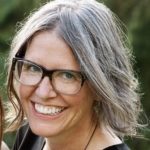Transformative Educational Leadership Journal | ISSUE: Fall 2019
Educational leaders must strive for continual growth within their communities with wellness as the foundation. Without wellness there can be no learning as learning is central to a robust education system that can endure.
By Angela Stott
As educators, we do a disservice to our colleagues and students if we do not make time to grow as learners and develop our leadership capacities within the context of our work.
Further, school and district leaders – across all roles – need to invest in staff by nurturing a deep learning community committed to trust, open communication, reflection, growth and curiosity; these are the communities that respond with resilience to changing and challenging times – communities that, by definition, endure. Such communities are “sustainable, interdependent, creative, flexible, life-centered, and guided by the values of the heart” (Cajete, pg. 110). If we are building communities that can endure, we must strive for continual growth with wellness as the foundation, because without wellness there can be no learning and we know that learning is central to a robust education system.
In the past decade, social and emotional learning (SEL) has gained a firm footing as essential skill development and learning for students. It is now time to turn our learning in this arena inward; increasing evidence suggests that educator wellness plays a substantial role in achieving a successful and sustainable school community (Aguilar, 2018). Arguably, we work a lot harder to help students achieve wellness without seriously considering that “wellness through the community and for all community members is the central concern in organizing the community’s activities” (Cajete, pg. 111). Indeed, Cherkowski and Walker (2018) argue that “we need to consciously attend to and support teacher wellbeing in similar ways that we are attending to student wellbeing in schools” (pg. 3). To build a community that can endure, “leaders can’t ‘be’ or ‘do’ wellness for teachers; but… are difference-makers for the wellbeing of teachers” (pg. 131). Clearly, as we move into the third decade of the 21st century, school and district leaders need to attend to nurturing a collective sense of self-worth and belonging in order for our systems to endure.
Participation in a community of learning is a characteristic of enduring communities as defined by Charles and Samples (2004). Active participation with each other as learners is required in order to spread deeper learning through a focus on symmetry (Watkins, Peterson and Mehta, 2018). Symmetry reflects a desire to shift focus from the individual to the collective with a notable “shift in focus toward collaborative capacity building amongst educators” (pg. 13). Cajete suggests we concern ourselves less with the individual and more with the whole – that we look toward collective achievement rather than individual achievement. Fortunately, in British Columbia, guiding documents espouse the message of learning as relational, “focused on connectedness, on reciprocal relationships, and a sense of place” (First Peoples Principles of Learning, 2008). As leaders, we must support and nurture adult learning; “creating safe, brave, and collaborative space for sharing and exploring our thoughts, feelings, truths, and stories is one of the simplest yet most profound ways educators can begin to effect change in our schools, society, and selves” (Drago-Severson & Blum-DeStefano, pg. 476). It is through a commitment to collective ownership and a responsibility for learning that a school or district’s leadership a community that can endure.
At the core of successful community, one that endures, is a collective responsibility for lifelong learning.
Although Charles and Samples suggest that “successful communities encourage and support lifelong learning among their community members” (Cajete, pg. 111), Fullan pushes us further and suggests that the “collective capacity building of adults to engage together in complex learning, [enables them to] create complex learning environments for their students” (Watkins et al, pg. 20). It is our moral imperative to continually learn, to improve practice, to pay attention to research, and to remain actively aware of our context and our place within the learning environment. Claxton (2002) suggests that there are four big learning habits:
- resiliency,
- resourcefulness,
- reflectiveness, and
- attaining and maintaining reciprocal relationships.
Though all valid, the latter is essential: a commitment to professional growth where momentum is maintained by open, honest communication developed through trusting and respectful relationships. Trust decreases risk, normalizes mistakes, and encourages curiosity. Educators’ lifelong learning is a necessary measure in sustaining a community that will endure.
Charles and Samples’ fourth criterion is mirrored in the research findings of Julie Sauve (personal communication, April 8, 2019) which posits that educators find joy and passion in working with students and helping them thrive. “When community members thrive in their work, the community benefits as well” (Cajete, pg. 111). As school and district leaders, we must nurture an environment where opportunities to thrive are built into the fabric of the learning community. Leaders need to ask ourselves what we are doing, on purpose, to ensure that all community members feel a sense of self-worth, that they believe their work matters, and that they feel success in the work they undertake. Further, we need to ensure that we, as learning leaders, are taking care of ourselves, to ensure that we are also thriving in the daily business of our work. Bottom line: educators “need and deserve environments that will support them in ensuring they can attend to self-care so that they can thrive in their work” (Cherkowski and Walker, pg. 23). While it may be true that we will survive if we do not establish practices of open communication, fair appraisal of work, and a supportive environment focused on flourishing as community members, survival is not synonymous with thriving. Survival does not ensure we will endure.
In order to endure we must gather to connect, recharge and grow.
“Holding spaces for people to connect in happy and positive ways brings out the community’s creative, self-healing, and self-transforming potentials” (Cajete, pg. 111-112). Through these processes educators can define and redefine themselves as school community members, take on new roles, explore different approaches to learning and leading, and further grow in their work. It is essential, in the development of a community that can endure, that we look inward to develop these mechanisms rather than what, arguably, are typically offered as solutions. School and district leaders, in noticing “new ways of talking about teaching, such as ‘good teaching requires self-cultivation rather than self-sacrifice’” (Cherkowski and Walker, pg. 31), are growing an environment for constant curiosity, wonder and renewal. Words have power. Mindset has power. Connection is a basic human need, and must be intentionally fostered and cared for in order to have a community that can endure.
The challenging work begins when we subscribe to a collective capacity building model – from our nighttime custodians to our first-year teachers, our basketball coaches to our department heads – and work to consider our areas for growth and development. Though much is dependent on context, educators at all levels must attend to their own well-being and feel supported to do so within our complex work environments. We need to fully participate in our community in ways that contribute to the growth of the school, district or system. Participation can look like many things but a necessary component of that participation is engagement in learning to better oneself as well as others within the system.
Scanning for healthy, learning communities
Cajete (2015), in her work on human communities as ever-unfolding communities, refers to the work of Charles and Samples who have identified criteria for sustainable and successful communities. Scanning a school community or, more broadly, an entire district, leaders can ask of themselves:
- Am I nurturing a sense of wellness that affects all members of our school community and do my community members know that I am?
- Do I exist within a participatory community where it is clear that “thoughtful, healthy, authentic and mature” participation is a foundational function of a community that endures?
- Do I model lifelong learning and instill the value of continual learning through my actions and words?
- Am I growing a collaborative culture of teaching and learning where it is evident that working and learning together is far better than working and learning alone?
- How am I growing a joyful, supportive work culture and demonstrating a balanced life that allows for recharging, regrouping and redefining of roles?
Systems leaders want to build communities and be part of communities that are both sustainable and successful. It makes sense that these criteria are the foundation to the of developing relationships, repairing harm and looking toward “conscious community development [that] makes use of all the knowledge and skills for building community health” (Cajete, pg. 117).
As we move forward
Without an explicit, transparent commitment to growing and sustaining a community that endures, we will continue to survive in hierarchical, fear based districts, schools, and systems that inhibit the potential of those who have chosen this profession. We are more effective learners when we learn together, and we feel a sense of self-worth when we are learning ourselves and helping others to become better versions of themselves. A workplace where wellness is foundational is a learning community that can endure.
Aguilar, E. (2018). Onward: Cultivating emotional resilience in educators. San Fransisco, CA: Jossey-Bass.
Cajete, G. A. (2015). Indigenous Community: Rekindling the teachings of the seventh fire. St. Paul, MN: Living Justice Press.
Charles, C. & Samples, B. (2004). Coming home: community, creativity and consciousness. Fawnskin, CA: Personhood Press.
Cherkowski, S. & Walker, K. (2018). Teacher wellbeing: Noticing, nurturing, sustaining and flourishing in schools. Burlington: Word & Deed Publishing.
Claxton, G. (2002). Building learning power. Bristol: TLO Limited.
Drago-Severson, E. & Blum-DeStefano, J. (2017). The self in social justice: A developmental lens on race, identity, and transformation. Harvard Educational Review 87(4), 457 – 481.
Robinson, C. (2011). Student-centred leadership. San Francisco, CA: Josesey-Bass.
Watkins, J., Peterson, A. & Mehta, J. (2018). The deeper learning dozen: Transforming school district to support deeper learning for all [PDF file]. Retrieved from http://deeperlearningdozen.org


